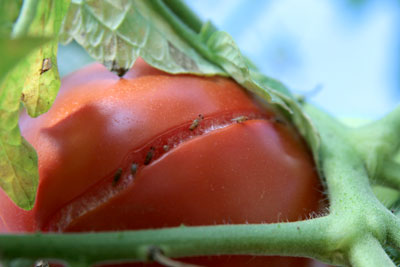At this time the major concern in my mind is the number of leafhoppers I am seeing on beans, potatoes, and other crops too. Check the June 6 Pest Report for details on this pest, and scout your crops. Of course, the other major concern is wet weather, again. But I don’t want to talk about it.
Pests and diseases coming up soon may be even worse. In this issue I will briefly cover the spotted wing drosophila and late blight. I will include links to more detailed reports.
Spotted Wing Drosophila
Late Blight
 |
| Spotted wing drosophila on a tomato. Luckily, they only seem to go after cracked tomatoes. |
 |
| Spotted wing drosophila larva in a raspberry. |
The spotted wing drosophila (SWD) has been found in Maine this week, and was found in southern New England a week or two ago. Only a few flies have been caught in traps set up to monitor the pest. It is in such low numbers that it is not a concern to fruit ripening now. But this pest has a proven record of explosive growth, and growers of soft fruits that ripen in August must be aware of the issue and make management decisions.
This fruit fly is a new pest in our region. It is a common pest in parts of Asia. The tiny fly looks like a typical fruit fly, but the males have a spot on each wing that you can barely see with the naked eye. Common fruit flies that we see here only go after over ripe and rotting fruit. The SWD is a much greater problem because it can attack sound fruit and has been very damaging to raspberries, blueberries and other late summer soft fruit. Two years ago was the first year it was seen in large numbers in northern New England. Last year on my farm in New Hampshire, nearly every raspberry and blackberry that ripened from mid August on had a maggot in it.
The fly lays eggs in the fruit and in a few days, perhaps on your customer’s counter, maggots will be wriggling. In as few as 8 days it goes from eggs to new adults laying more eggs. The populations can explode quickly. And this is what has happened the past two years and is expected to happen again. A small population survives the winter, in early summer we start seeing a few flies around, by mid August fruit is being ruined, and by September nearly all soft fruit is being ruined. Some people escaped the damage last year.
Research is being done on various management practices for this new pest. At this time I do not have any fully tested recommendations. Here are some tips that have been learned in the past two seasons of dealing with this pest.
1) Trapping – Traps are very successful at monitoring the pest. The question that remains and is being researched this year is are traps useful for trapping out enough of the population to be an effective management technique. Here is a link to what has proven to be the best trap design:
www.uvm.edu/vtvegandberry/SWD/2013_SWD_Trapping.pdf
2) Netting to exclude the pest- Using nets such as Proteknet has proven successful. Whether this is practical is another question. Here is a link to a good source for commercial netting:
www.duboisag.com/en/proteknet-insect-netting.html
3) Cooling the fruit after harvest- After harvesting do not leave what looks like clean fruit on the counter at room temperature. You may be in for a surprise. Keep the fruit refrigerated until consumption, or freeze, and you may never know about any problem.
4) Pesticides are quite effective at killing this pest, but because of its quick generation time, and ability to migrate in quickly, spraying would have to be done more often then I could comfortably recommend. It turns out that spinosad (Entrust or Monterey Garden Spray) is among the best insecticide, even better than many conventional pesticides. However, not only is there reluctance to spray as often as would be necessary, there is a label restriction that crops may not be sprayed more than 3 times per season.
If you would like to read a lot more about this new pest, there are some very good fact sheets out there. I recommend the one from Penn. State:
extension.psu.edu/plants/vegetable-fruit/fact-sheets/spotted-wing-drosophila-1
 |
| Late blight on a potato leaf. |
The weather this year is as about as good as it gets for late blight. And, late blight has been found (in western Massachusetts, central New York and New Jersey and just this week in the County in Maine). It is still at a very low level and that speaks well to me of the efforts everyone is doing to manage it. For the most part, late blight only overwinters in New England in potato tubers and the low level of the disease this summer with this awful weather must be due to proper handling of diseased tubers, and the use of clean seed. Of course, no one brought in diseased seedlings to sell this year as they did in 2009, and that is a tremendous help.
On the other hand, with some late blight showing up here and there close to us, it is time to be vigilant. All of us need to be scouting our tomato and potato plants. If you find suspect plants, send me a picture or get a sample to your Extension educator.
For details about this pathogen and management of the disease, go to my article in The MOF&G: Late Blight Again? It’s Up to Us
